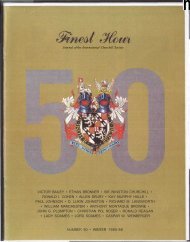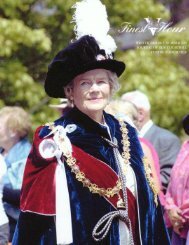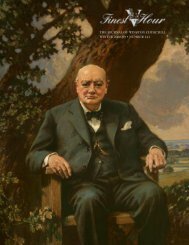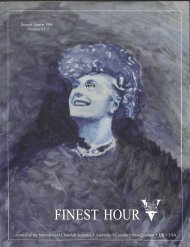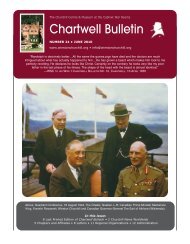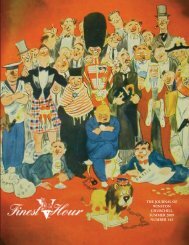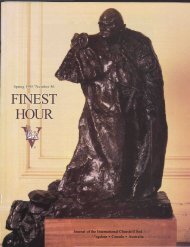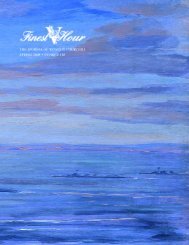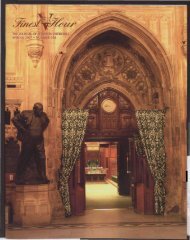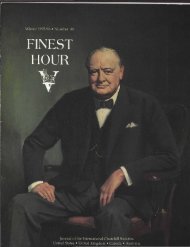You also want an ePaper? Increase the reach of your titles
YUMPU automatically turns print PDFs into web optimized ePapers that Google loves.
Gilman, Robert Bevan, John Nash and<br />
Edward Wadsworth. But to my disappointment,<br />
there was no mention of<br />
Morin or <strong>Churchill</strong>. This was a blow as<br />
well as a full stop. However as I<br />
thought further about everything, I<br />
came to some tentative conclusions:<br />
First, <strong>Churchill</strong>’s exhibition<br />
might have been a kind of temporary<br />
“display,” which is not an uncommon<br />
practice for commercial galleries.<br />
Second, Montag and Bodkin<br />
almost certainly knew each other professionally.<br />
Both were enthusiastic<br />
about <strong>Churchill</strong>’s talents as an artist<br />
and Montag was the likely source of<br />
Bodkin’s 1953 story about the Paris<br />
sale of <strong>Churchill</strong>’s pictures. The passage<br />
of time and intervention of World War<br />
II might also explain Bodkin’s inaccurate<br />
references to WSC’s pseudonym,<br />
and his dating the Paris exhibition<br />
“shortly before” World War II.<br />
These mysteries were soon compounded.<br />
As the author of the official<br />
catalogue of <strong>Churchill</strong>’s paintings and a<br />
guardian of his reputation in this<br />
regard, I’m quite often sent for my<br />
opinion images of hitherto unknown<br />
pictures said to be by Sir <strong>Winston</strong>,<br />
often signed with initials. Neither the<br />
initials nor the paintings are generally<br />
found to be his work—not only for<br />
technical reasons, but because of the<br />
lack of provenance stretching back to<br />
<strong>Churchill</strong> himself.<br />
Yet in 2008, to my total astonishment,<br />
I was sent from two different<br />
sources images of two landscapes,<br />
clearly signed “Charles Morin.” Neither<br />
was in any way typical nor representative<br />
of <strong>Churchill</strong>’s known subjects, nor<br />
was either painted in anything<br />
approaching his usual manner. Both<br />
showed, however a definite professional<br />
deftness and hand.<br />
Some basic research confirmed<br />
that Charles Camille Morin (1846-<br />
1919) was in fact a known and<br />
exhibited French artist who painted<br />
landscapes in a style derived from the<br />
earlier French Barbizon School. 9 A<br />
description of both pictures confirmed<br />
that they were his.<br />
So here is the big question: Why<br />
in 1921 was <strong>Churchill</strong> assigned the<br />
pseudonym of a well-known French<br />
artist dead for two years<br />
While we don’t know the subjects<br />
of <strong>Churchill</strong>’s paintings exhibited<br />
in Paris in 1921, it is interesting to<br />
speculate. In the circumstances of the<br />
occasion, they are likely to have been<br />
French scenes. And, while we may<br />
never know the actual pictures, there<br />
may be clues in the illustrations<br />
<strong>Churchill</strong> chose for his 1921-22 Strand<br />
Magazine article “Painting as a<br />
Pastime.” Perhaps one was of Mimizan,<br />
his friend the Duke of Westminster’s<br />
property near Bordeaux (page 31).<br />
Another might have been a favourite<br />
haunt in the South of France such as<br />
St. Jean Cap Ferrat (page 32).<br />
So much for conjecture. For the<br />
sake of the artist, let us put aside these<br />
unanswered questions and turn to the<br />
warm friendship between a President<br />
and Prime Minister.<br />
In December 1941 Franklin<br />
Roosevelt received a letter from Edward<br />
Bruce, chief of the Smithsonian’s Fine<br />
Arts Section, asking him to forward a<br />
message to “Charles Marin,” cheekily<br />
inviting the artist to lunch. Bruce was<br />
under the impression that “Marin” was<br />
<strong>Churchill</strong>’s pesudonym. As Roosevelt<br />
told <strong>Churchill</strong> later, Bruce was “an old<br />
friend and a really grand person—but<br />
completely unorthodox.” Bruce’s letter<br />
led to an exchange of telegrams at official<br />
level between Washington and<br />
London enquiring about “the Prime<br />
Minister’s nom de palette.” Back came<br />
the answer on 31 January 1942 from<br />
<strong>Churchill</strong>’s private secretary: “Correct<br />
name is CHARLES MORIN not repeat<br />
not MARIN.” 10<br />
These telegrams were discovered<br />
for me by Dr. Lynsey Robertson of the<br />
<strong>Churchill</strong> Archives Centre, when I was<br />
on the hunt for references to<br />
<strong>Churchill</strong>’s use of the Morin pseudonym.<br />
She also generously directed<br />
me to a published letter from Roosevelt<br />
in February 1942, asking <strong>Churchill</strong><br />
about his use of a nom de palette (part<br />
of this letter I have already quoted<br />
above): “These people who go around<br />
under assumed names render themselves<br />
open to all kinds of indignity<br />
and suspicion,” wrote the President.<br />
“Some day I want to see a painting by<br />
this alias fellow—and some day I hope<br />
FINEST HOUR 148 / 35<br />
you will get enough time to resume the<br />
painting and that I will be able to<br />
return to making ship models and collecting<br />
stamps!” 11<br />
As it happens, that wish was<br />
granted in part, sooner surely than<br />
either friend expected. In 1943, after<br />
the Casablanca Conference, <strong>Churchill</strong><br />
insisted to Roosevelt: “You cannot<br />
come all this way to North Africa<br />
without seeing Marrakesh....I must be<br />
with you when you see the sun set on<br />
the snows of the Atlas Mountains.”<br />
After their joint visit, the Prime<br />
Minister painted the scene, “the only<br />
picture I ever attempted during the<br />
war” (opposite) which he later gave to<br />
Roosevelt as a memento. 12 ,<br />
Endnotes<br />
1. <strong>Churchill</strong> Archives Centre,<br />
Cambridge, CHAR 16/75/20-21, with kind<br />
assistance of Dr. Lynsey Robertson.<br />
2. Martin Gilbert, <strong>Winston</strong> S.<br />
<strong>Churchill</strong>, vol. IV The Stricken World 1917-<br />
1922 (London: Heinemann, 1975), 515.<br />
3. Martin Gilbert, ed., <strong>Winston</strong> S.<br />
<strong>Churchill</strong>, Companion Volume IV, Part 2,<br />
Documents, July 1919-March 1921 (London:<br />
Heinemann), 1307, n. 2.<br />
4. Charles Eade, ed., <strong>Churchill</strong> by His<br />
Contemporaries (London: Hutchinson, 1953),<br />
420-21. Coincidentally it was in 1947, at a<br />
Royal Academy exhibition, that I as a small<br />
boy first saw a <strong>Churchill</strong> painting, “Winter<br />
Sunshine, Chartwell” (opposite).<br />
5. Mary Soames, <strong>Winston</strong> <strong>Churchill</strong>:<br />
His Life as a Painter (Boston: Houghton<br />
Mifflin, 1990), 38.<br />
6. Celia Lee, Jean, Lady Hamilton<br />
1861-1941: A Soldier’s Wife (London: Celia<br />
Lee, 2001), 237.<br />
7. Life as a Painter, 39<br />
8. <strong>Winston</strong> S. <strong>Churchill</strong>, “Painting as a<br />
Pastime,” The Strand Magazine, December<br />
1921 and January 1922. The quotation is<br />
from the book version of this long essay<br />
(London: Cassell, 1948), 27-28.<br />
9. Charles Morin entry, Benezit<br />
Dictionary of Artists (Paris: Grund, 2006).<br />
10. <strong>Churchill</strong> Archives Centre,<br />
Cambridge, CHAR 2/446A/38-39. “Marin”<br />
is French for sailor: could Bruce have been<br />
hinting at the “Former Naval Person” -PHC<br />
11. Warren F. Kimball, ed., <strong>Churchill</strong><br />
and Roosevelt: The Complete Correspondence,<br />
3 vols. (Princeton: Princeton University Press,<br />
1984), I:358-59.<br />
12. <strong>Winston</strong> S. <strong>Churchill</strong>, The Second<br />
World War, vol. IV, The Hinge of Fate<br />
(London: Cassell, 1951), 622-23.



